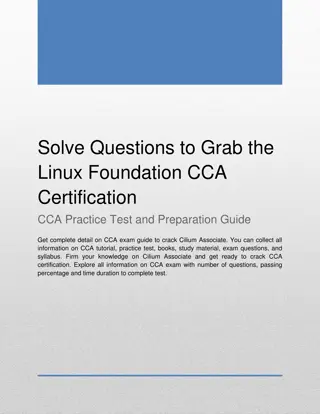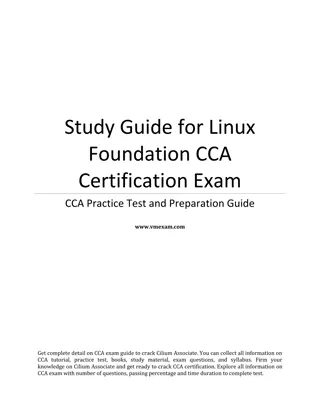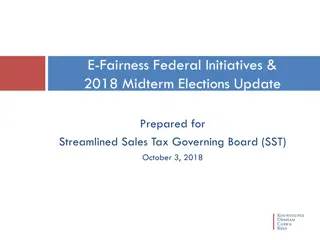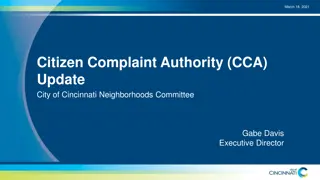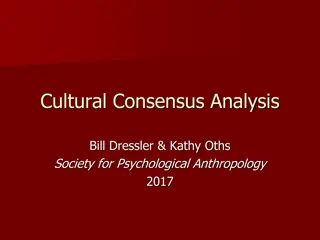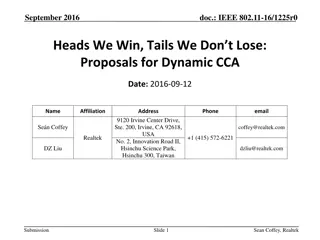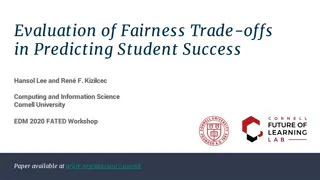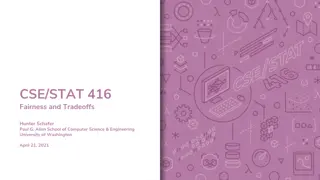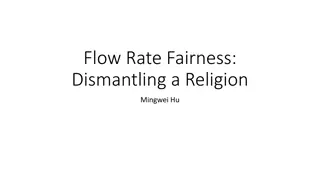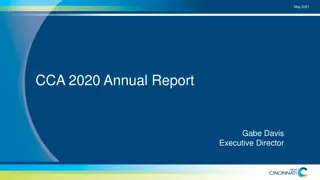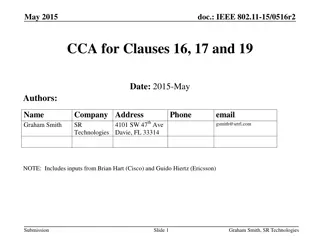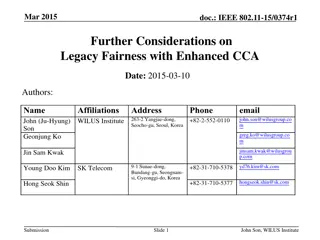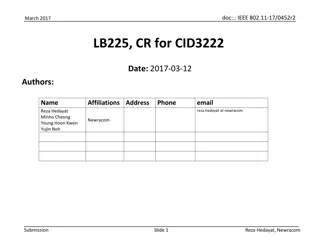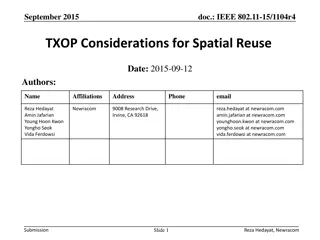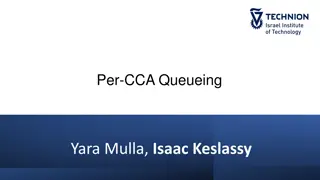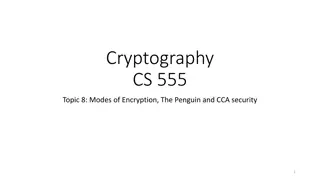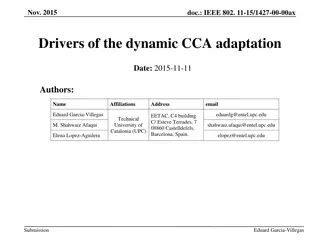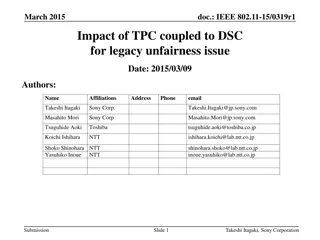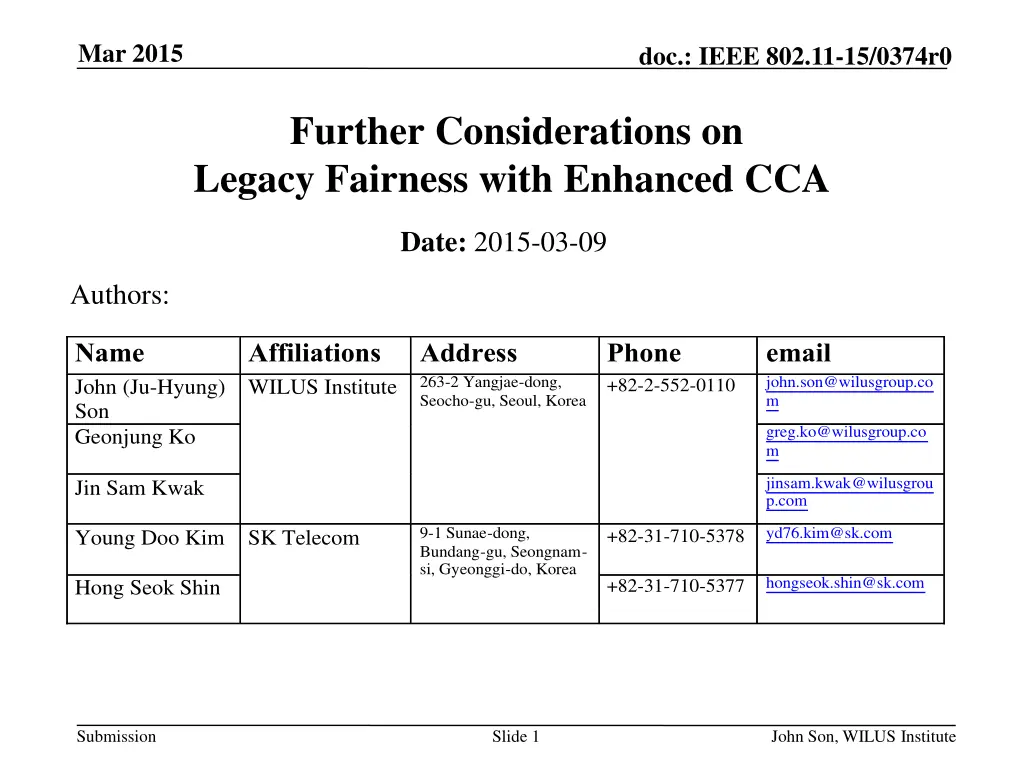
Legacy Fairness Considerations in Enhanced CCA Evaluation
Explore legacy fairness issues in enhanced clear channel assessment (CCA) for IEEE 802.11 networks. Methods to mitigate legacy device starvation from high-efficiency (HE) devices are examined through simulations. Contention unfairness and provisioning solutions are discussed.
Download Presentation

Please find below an Image/Link to download the presentation.
The content on the website is provided AS IS for your information and personal use only. It may not be sold, licensed, or shared on other websites without obtaining consent from the author. If you encounter any issues during the download, it is possible that the publisher has removed the file from their server.
You are allowed to download the files provided on this website for personal or commercial use, subject to the condition that they are used lawfully. All files are the property of their respective owners.
The content on the website is provided AS IS for your information and personal use only. It may not be sold, licensed, or shared on other websites without obtaining consent from the author.
E N D
Presentation Transcript
Mar 2015 doc.: IEEE 802.11-15/0374r0 Further Considerations on Legacy Fairness with Enhanced CCA Date: 2015-03-09 Authors: Name John (Ju-Hyung) Son Geonjung Ko Affiliations WILUS Institute Address 263-2 Yangjae-dong, Seocho-gu, Seoul, Korea Phone +82-2-552-0110 email john.son@wilusgroup.co m greg.ko@wilusgroup.co m jinsam.kwak@wilusgrou p.com Jin Sam Kwak 9-1 Sunae-dong, Bundang-gu, Seongnam- si, Gyeonggi-do, Korea yd76.kim@sk.com +82-31-710-5378 Young Doo Kim SK Telecom +82-31-710-5377 hongseok.shin@sk.com Hong Seok Shin Submission Slide 1 John Son, WILUS Institute
Mar 2015 doc.: IEEE 802.11-15/0374r0 Abstract In [1], we investigated legacy fairness issues of enhanced CCA. Legacy STA s throughput can be starved from HE STA s increased CCA threshold and continuous channel occupation. In this contribution, we evaluate two fairness methods: Legacy Frame Protection [2]where HE STA does not apply increased CCA threshold on legacy frames; PPDU Size Reduction where HE STA limits its PPDU sizes (or TXOP duration [3]) when they obtain a channel with increased CCA threshold. From simulation studies, we show that the above methods effectively mitigate legacy starvations upto moderate CCA threshold levels. Also, we report a new contention unfairness that may arise when there are multipl HE STAs around Leg STAs. Submission Slide 2 John Son, WILUS Institute
Mar 2015 doc.: IEEE 802.11-15/0374r0 Legacy Fairness Issues [1] 1. CCA threshold unfairness 2. Airtime unfairness HE CCA (e.g. -82dBm) range of Legacy STA CCA (e.g. -62dBm) range of HE STA HE Leg HE Leg HE Data Data backoff HE Data Data HE Data Data backoff backoff Leg Data Leg defer backoff defer defer HE STA applies increased CCA threshold on Legacy frames HE STA can continuously access the medium thus unfair to Legacy STA Two HE STAs apply increased CCA threshold on mutual HE frames HE STAs can continuously occupy the channel thus unfair to Legact STA (Solution) Legacy Frame Protection (Solution) PPDU Size Reduction Submission Slide 3 John Son, WILUS Institute
Mar 2015 doc.: IEEE 802.11-15/0374r0 Fairness Provisioning Methods Legacy Frame Protection PPDU(TXOP) Size Reduction If RSSI>= CCA-SD , If preamble passes, If MYDATA, receive the packet. If HE-frame of OBSS, apply CCA-SD-HE If HE-frame of MYBSS, apply CCA-SD If Legacy frame, apply CCA-SD If preamble fails, apply CCA-ED HE Data Data defer backoff backoff HE Data Data defer backoff backoff Leg Data backoff remaining backoff HE STA limits its PPDU size to fit within the on-going HE frame (In simulation, we limit the # of MPDUs in A-MPDU) TXOP HE STA applies increased CCA threshold only when OBSS HE frame is observed [2] HE Data Data TXOP Data HE Data Data Data Leg Data back off HE STA limits its TXOP duration to fit within the on-going HE STA s TXOP duration [3] Submission Slide 4 John Son, WILUS Institute
Mar 2015 doc.: IEEE 802.11-15/0374r0 Simulation Settings Topography/Channel Model [4][5] 1 floor, 1x2 apartments per floor, each apt. is 10m x 10m x 3m 1 AP, 4 STAs per apt. (1 HE STA, 3 Legacy STAs) AP/STA at random (x,y) locations, all with z=1.5 5GHz, all BSS has the same 80MHz channel (Reuse 1) Pathloss model with Wall/Floor penetration loss, 5dB std log-normal shadowing, no multipath fading Le g Le g Le g Le g HE HE Le g Le g HE HE Traffic DL+UL full buffer Packet size: 1500 Byte, MHE A-MPDU=8 MCS selection: Fixed MCS 0 CCA threshold CCA-SD: -82dBm CCA-SD-HE: -82, -72, -62, -52 dBm Submission Slide 5 John Son, WILUS Institute
Mar 2015 doc.: IEEE 802.11-15/0374r0 Throughput & Fairness ? ? No? method? ? ? ? ? ? ? ? ? ? ? ? ? ? ? ? ? ? ? ? ? ? ? ? ? ? ? ? ? ? ? ? ? ? ? ? LFP? only? ? ? ? ? ? ? ? ? ? ? ? ? ? ? ? ? ? ? ? ? ? ? ? ? ? ? ? ? ? ? ? ? ? ? ? LFP+PSR? Jain's? Fairness? Index? [6]? (HE? STA? vs.? Leg? STA)? 25? 1? LFP+PSR? Leg? STA? HE? STA? LFP? only? No? method? 20? 0.9? Fairness? Index? Throughput? (Mbps)? 15? 0.8? 0.7? 10? 0.6? 5? 0.5? 0? (-82dBm)? (-72dBm)? (-62dBm)? (-52dBm)? (-82dBm)?(-72dBm)?(-62dBm)?(-52dBm)? (-82dBm)?(-72dBm)?(-62dBm)?(-52dBm)? (-82dBm)?(-72dBm)?(-62dBm)?(-52dBm)? Without fairness method large unfairness between HE STA vs. Leg STA (starvation of Leg STA) as CCA threshold increases. LFP (Legacy Frame Protection) only prevent legacy starvation up to moderate CCA threshold (-72dBm). LFP+PSR (PPDU Size Reduction) prevent legacy starvation up to high CCA threshold (-62dBm). Submission Slide 6 John Son, WILUS Institute
Mar 2015 doc.: IEEE 802.11-15/0374r0 Contention unfairness Le g X HE 1 Le g HE Leg? STA's? average? rela ve? throughput? drop? 1? 3HE-1Leg Case Example 1HE-3LEG? HE HE 2HE-2Leg? 0.9? 3HE-1Leg? HE 3 HE 2 HE HE 0.8? 0.7? HE Data Data Ra o? backoff 0.6? HE 1 HE 2 HE 3 Data defer backoff backoff 0.5? remaining backoff remaining backoff Data defer backoff 0.4? defer backoff defer 0.3? Leg X defer defer backoff 0.2? (-82dBm)? (-72dBm)? (-62dBm)? (-52dBm)? We also found the Contention unfairness issue where HE STAs can decrement their contention windows due to from increased CCA threhold while Leg STA cannot. This unfairness becomes severe when Leg STA is with many neighbor HE STAs in a BSS. Submission Slide 7 John Son, WILUS Institute
Mar 2015 doc.: IEEE 802.11-15/0374r0 Summary Legacy fairness is an important requirement when 11ax designs a new spatial reuse technology. In this contribution, we demonstrated that previously discussed two fairness methods can preserve legacy fairness. We also identified the Contention unfairness issue that needs further discussions in 11ax. Submission Slide 8 John Son, WILUS Institute
Mar 2015 doc.: IEEE 802.11-15/0374r0 References [1] 11-15/0085r1, Legacy Fairness Issues of Enhanced CCA [2] 11-14/0629r0, Further discussions on Enhanced CCA [3] 11-14/0637r0, Spatial Reuse and Coexistence with Legacy Devices [4] 11-14/0980r6, Simulation Scenarios [5] 11-14/0571r7, Evaluation Methodology [6] Jain, R.; Chiu, D.M.; Hawe, W. (1984). "A Quantitative Measure of Fairness and Discrimination for Resource Allocation in Shared Computer Systems". DEC Research Report TR-301. Submission Slide 9 John Son, WILUS Institute

